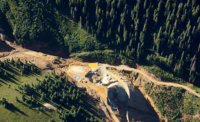The U.S. Congress’ House Committee on Natural Resources says the Environmental Protection Agency’s engineers don’t have the skills to manage mine remediation work because of Colorado’s Gold King Mine disaster in August, when 3 million gallons of toxic wastewater were spilled into the Animas and San Juan rivers during an EPA-led effort to reopen the mine.
In a February report, Congress said the EPA demonstrated a total lack of standard engineering procedure and protocol and has since tried to cover up the mistakes it made. “The incompetence and willful efforts to evade consequences in this report demonstrate EPA cannot be trusted to spearhead remediation of sites like the Gold King Mine,” said the committee’s report.
After monitoring the Gold King Mine’s wastewater drainage for years, EPA began excavation at its easternmost entrance, in September 2014. EPA On-Scene Coordinator (OSC) Steven Way soon decided that crews were not prepared to drain the flooded entrance of the mine to reopen it, postponing further excavation work at the site for almost a year.
In the meantime, engineers misjudged the height of the flooded entrance floor and the location of drainage pipes. They incorrectly assumed that the buildup of water resulted from seasonal in-flows, rather than a blockage, the report says, adding, “Thus, the team assumed that the entrance was not pressurized and did not test the pressure prior to excavation a year later.”
That was the big mistake made by OSC Hays Griswold, who took over for a vacationing Way, the report said. Way had left explicit instructions not to excavate at the level of the drainage pipe without pumping equipment ready and waiting. Crews ignored those instructions and dug directly at the entrance plug. “Within minutes … it violently blew out,” the report notes.
The report’s ultimate message is that standard engineering procedure—such as the use of scaled drawings—could have prevented the disaster. Nevertheless, critics of EPA’s level of competence to clean up hazardous waste sites are mistaken, said EPA spokeswoman Nancy Gratham in a mailed statement to ENR.
“Throughout EPA’s three decades of cleaning up waste sites through the Superfund response program, the agency has used an interdisciplinary approach to address sites that includes employing scientists and engineers, including those with mine-related degrees and experience in project manager positions.”
Congress says Way, Griswold and other crew showed “troubling … rationale” and “total incompetence.”
EPA countered by saying its coordinators must undergo a three-year training program, including 160 hours of health and safety courses. “Many of these require an annual or biannual refresher training to maintain certification, including a competency exam for each course,” Gratham said.
“EPA Region 8’s mining coordinator has a Mining Engineering degree from Colorado School of Mines, [and the] OSC on site during the Gold King Mine incident has a Geological Engineering degree from Colorado School of Mines,” Gratham wrote.
When performing mine remediation work, EPA also uses private companies with highly qualified scientists and mining engineers, Gratham claimed, adding, “For Gold King Mine, EPA included professional engineers in the work’s planning, and a professional engineer was present on site during work on August 5.”
The investigation into the incident is not over. House Republicans have subpoenaed the Dept. of the Interior and Army Corps of Engineers for records related to the Corps’ peer review of DOI’s technical evaluation of the blowout.
The week after Congress was reporting that EPA should not administer mine cleanup projects, Colorado officials in Silverton and San Juan County voted unanimously for the state to request a Superfund designation—a move that would increase EPA’s role in the area.
Animas River communities had resisted the Superfund designation for more than two decades, maintaining it could rid any chance of the return of the mining industry and severely harm the tourism-dependent economy in the region.


